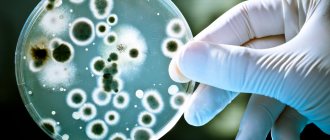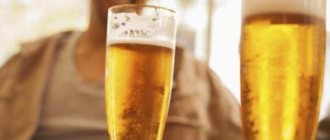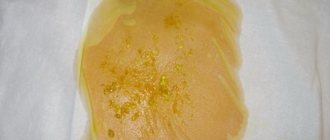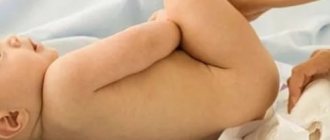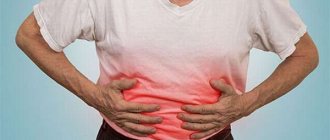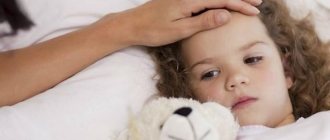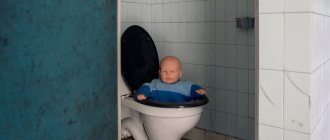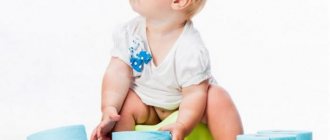Loose stools, or diarrhea in common parlance, is a digestive disorder that occurs quite often in both infants and schoolchildren - in children of any age. Many parents believe that the appearance of unnoticeable mucus in a small amount in the child’s stool is the norm. What can lead to diarrhea and when to sound the alarm, we will consider further. The main cause of this condition is the ingestion of substances from food that irritate the gastrointestinal tract or are intolerable to the child. There are few options for children under 12 months: such substances can get into breast milk, formula, drinks (water, baby tea, etc.) or complementary foods. In breastfed babies, diarrhea is a rare occurrence, but in formula-fed babies and children at the stage of introducing complementary foods, it is quite common.
The second common cause of diarrhea is infection: viruses, bacteria and fungi can enter the child’s body with food, water, as well as through contact and household contact, through the dirty hands of the mother or baby, if basic hygiene rules are not followed.
Errors in nutrition are the third cause of diarrhea. Early introduction of complementary foods, overload of the digestive tract (especially the introduction of several new products at once), exceeding the frequency of meals - all this leads to the fact that the gastrointestinal tract cannot cope and dysfunction occurs, which is manifested by diarrhea.
Causes of loose stools with mucus in children
Many parents believe that the appearance of unnoticeable mucus in a small amount in the child’s stool is the norm. And even if a child has diarrhea with mucus (reasons), this is not yet a clear sign of the disease. However, mucus is always a sign of irritable bowel: normally there should be no mucus in the stool! In children under two years of age, this happens much more often than in older children, since the intestines of children are more sensitive to bacteria and microorganisms that enter the gastrointestinal tract.
Most often, loose stool in a child is caused by the following reasons:
- eating disorder
- high content of vegetables and fruits in the diet
- diarrhea in baby during teething
- colds
- taking antipyretics
- simple overexcitement
- climate change.
This is not dangerous and in most cases this disorder goes away on its own. With loose stools, the child’s general condition does not suffer greatly from these reasons.
Also, mucus in a baby’s stool may appear due to non-sterility of breast milk. Then it is better for the baby’s mother to take the appropriate test in a paid laboratory and reconsider her diet. More serious reasons include:
- overeating (see how to properly introduce complementary foods to children)
- enterocolitis
- intolerance to cow's milk, gluten (see is it possible to give cow's milk to children under one year old)
- gastroenteritis
- lactase deficiency
- helminthic infestation
- poisoning
- dysbiosis.
Prevention of loose stools in a newborn
To avoid this problem, it is worth carefully selecting the mother’s diet, feeding the baby in sufficient quantities - moderately, in accordance with its needs, introducing complementary foods in a timely manner (no earlier than 6 months), starting with “delicate” foods, massaging the belly clockwise to improve peristalsis and avoid dyspeptic symptoms.
Thus, it is fair to say that diarrhea with mucus in a child can be both a normal variant and a pathology. The accompanying symptoms are of decisive importance, by which you can understand whether your baby’s condition is physiological or whether it is worth seeing a doctor.
How to understand that loose stools are diarrhea (diarrhea)
First, let's talk about norms.
- In a breastfed baby, stool can accompany each feeding, up to 8 times a day.
- When bottle-fed, babies have stools less often, up to 4 times a day.
- After the introduction of complementary foods, the frequency of bowel movements approximately equalizes, both in children who are still fed breast milk and in babies receiving formula, more often - up to 3 times a day.
When breastfeeding, stool can be either liquid or mushy; the consistency and shade of stool depend on what is present in the nursing mother’s diet; the smell is somewhat similar to the smell of kefir.
Thus, watery stool with a greenish tint in a baby feeding at the breast, with lumps of undigested milk, is the norm, but only if the baby feels well, is gaining weight and behaves normally!
The stool of a child fed formula is denser, almost always the same color and characteristic smell.
What then is considered diarrhea? Defecation, the appearance, smell and quantity of which is not included in the usual number of bowel movements per day. But you need to remember that all children are different and you cannot compare them with each other - the loose stool that we see in a photo posted by some mom on the forum is not necessarily a model that we should emulate!
There are so-called diagnostic criteria that allow you to identify diarrhea from normal stool:
- bowel movements have increased significantly, at least twice as often;
- the stool has become watery;
- stool contains unusual impurities;
- the color of feces has changed with a normal diet, including discoloration;
- the child is restless, eats and sleeps poorly, knocks his legs;
- there is increased gas formation;
- an unpleasant odor emanates from stool;
- Irritation and redness appeared around the anus.
Attention! You need to inform your pediatrician about every case of increased stool frequency, the appearance of atypical or more frequent bowel movements than usual! For children under one year old, this is mandatory - you need to call a doctor at home!
Aggravating circumstances include:
- foamy or watery stools that have lost their fecal character (wet spots on a diaper or diaper)
- blood in loose stools
- copious mucus in the stool.
But the situation becomes more serious if the child’s diarrhea is caused by an intestinal infection or appears during or after taking antibiotics (dysbacteriosis). It is necessary to urgently call a doctor if your child develops:
- watery stools with mucus more than 6 times a day
- feces with a strong foul odor
- green diarrhea in infants or diarrhea in the form of orange flakes
- high fever combined with diarrhea
- stool in the form of raspberry jelly or blood in liquid stool,
- diarrhea combined with regurgitation (especially fountain),
- concomitant serious condition - the child is lethargic, refuses food and food, urination is rare or absent.
In addition, if a baby has loose stools combined with frequent regurgitation, the baby has poor weight gain - this indicates serious health problems. A doctor will help determine the cause of loose stools in a baby by sending him for the appropriate tests - coprogram, general blood test, stool test for dysbacteriosis. Diarrhea in children after antibiotics is almost always caused by intestinal dysbiosis. Therefore, any use of antibacterial agents is recommended to be accompanied by means to maintain the normal microflora of the baby according to age and the recommendations of the pediatrician (see).
| Feces with colienteritis | Putrid feces with one-sided protein feeding | Hungry stool | Meconium |
| Dysentery feces | Feces for nutritional dyspepsia | Acholic feces in biliary atresia | Mesose-like homogeneous feces (for breastfeeding) |
| Feces with intestinal infantilism | Feces for nutritional dyspepsia | Stool for neonatal melena | Feces of a baby fed cow's milk |
Causes
Green diarrhea can occur for many reasons. Feces may become greenish in color, oxidizing when exposed to oxygen, if the baby's diaper is not changed in time.
In addition, the stool may change color due to the foods that the nursing mother took - zucchini or cucumbers.
Some medications that are designed to increase the iron content in the body can also turn stool greenish.
If the body accumulates more iron than necessary, it excretes it in the feces, which oxidizes, disrupting the child’s intestinal microflora.
It also cannot be ruled out that green, loose stools may indicate the presence of an intestinal or bacterial infection in the baby’s body.
Acute attack of diarrhea
During an acute attack of diarrhea, a child may experience loose stools eight to twelve times a day.
This condition is accompanied by abdominal pain, increased body temperature and even vomiting.
The cause of this condition may be an intestinal infection caused by bacteria, fungi, viruses or parasites.
At the first suspicion of an intestinal infection, you should immediately call a doctor, before whose arrival the infant should be given electrolytic solutions to drink to compensate for the loss of fluid in the body.
Tests needed to determine the cause of diarrhea in children
A complete blood count will help determine the “severity” of the infection. That is, how strong the inflammatory process is in the baby’s body. Based on the test result, the doctor will prescribe treatment.
- Coprogram
The coprogram can establish the presence of disturbances in the functioning of enzymatic systems, shows the functioning of the pancreas and helps to recognize the location of dysfunction in the digestive system, the severity of the inflammatory process, and pathological processes in the gastrointestinal tract. In an acute situation with diarrhea, it is almost always useless.
- Bacteriological analysis of stool + test for dysbacteriosis
It will help determine which pathogenic microorganisms are causing the baby’s digestive upset. This way you can identify Staphylococcus aureus, Klebsiella, Enterococcus, Proteus. In the same analysis, colonies of bifidum and lactobacilli are considered, which, as a rule, are very few in diarrhea in children. The analysis also allows us to establish a quantitative indicator of beneficial bacteria in the baby’s intestines. The disadvantage of this analysis is that it is completed within 5-10 business days and most often it will have to be done for a fee.
- A stool test for worm eggs and protozoa is necessary, as some helminthic infestations can cause periodic diarrhea in a child.
- Stool culture for typhoid-paratyphoid and dysentery group allows us to freely identify or refute these variants of infection.
- In the direction of the pediatrician, stool can be cultured for a specific suspected pathogen: staphylococci, rotaviruses.
Symptoms
Diarrhea in an infant can be acute or chronic.
The most basic alarming symptom is the frequency of bowel movements (from 4 to 10 times a day) and their nature, which depends on the cause that caused the diarrhea.
The normal water content in a baby's stool is 60%.
If the percentage of liquid is 90, then we can already talk about diarrhea.
The fact that a child has diarrhea can be judged by the following factors:
- the presence of blood streaks in the stool - this can be caused by a violation of the integrity of the intestinal walls and damage to the capillaries;
- the presence of mucus and pus in the stool, as well as a foul odor, indicate that some kind of inflammatory process is taking place in the intestines;
- There is a greasy sheen in the stool, and greasy marks remain on the toilet after flushing the stool. The pancreas may be inflamed.
How to treat diarrhea in an infant
Prolonged diarrhea in an infant is very dangerous; it leads to dehydration of the child's body in a very short time. What to give a child for diarrhea? First of all, it is necessary to restore the water-salt deficiency caused by diarrhea.
- The child should remain breastfed or bottle-fed. Give the breast as often as the baby asks, do not maintain the usual intervals!
- For formula-fed babies, it makes sense to slightly reduce the portions and feed the baby a little more often.
- If diarrhea in an infant is combined with frequent regurgitation (vomiting), there is no need to engage in amateur activities and treat it yourself. It is urgent to take the child to the hospital, where he will be given an IV, since infants become dehydrated much faster than adults.
- If it's just about diarrhea. You can try to fight dehydration on your own. In addition to the usual food (milk or formula), a child under one year old should drink the same amount per day that he approximately lost with the previous loose stool. Plus the volume of one feeding plus approximately 200 ml for each subsequent loose stool. They should be given special saline solutions (Regidron, Acesol, Oralit); pure baby water or sweet tea for children over one year of age are also suitable. If your baby drinks normally between feedings, give him water from a bottle, spoon, cup or syringe. If things get tough, give 1 teaspoon every 5 minutes.
- If nothing works out, don’t wait for complications and go to the hospital. Criteria for dehydration are drowsiness, dry lips, palms and soles, dull eyes, a poorly straightened fold on the tummy caught in the fingers, lethargy, and lack of urination.
The doctor may also prescribe treatment with Enterofuril, Stop-Diar in suspension, Furazolidone in tablets according to the instructions and dosage according to the child’s age (see symptoms of food poisoning, treatment of food poisoning, causes of diarrhea and vomiting in a child without fever, a complete list of all remedies for diarrhea) . Often, specific Klebsiella or staphylococcal diarrhea is treated with bacteriophages (intestibacteriophage, Staphylococcal, Klebsiella).
Diet for diarrhea in children
If an infant who is breastfed has diarrhea, the child recovers faster and they are less likely to have complications. It is necessary to combine breastfeeding with rehydration, breastfeed the baby more often and exclude vegetable complementary foods, juices, leaving cereals and meat.
For older children, a strict diet is necessary; indigestible foods, sweets, fatty foods, dairy products, salty foods, and foods rich in fiber are excluded from the diet. You can give crackers, tea, potatoes, bananas.
Author:
Selezneva Valentina Anatolyevna physician-therapist
